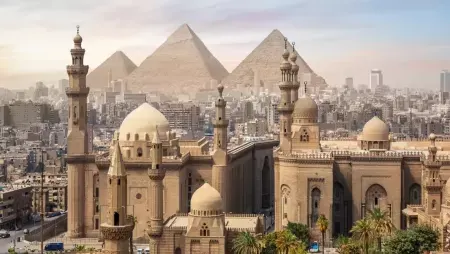Centuries ago, papyrus had so many uses in the typical daily life of an Egyptian. Created from the papyrus plant, it was used for writing, religious texts, and official recording. Today, it remains identified with ancient Egyptian civilization.
Introduction to Papyrus: History of Ancient Egypt
Before contemporary paper had the stage, the ancient Egyptians were recording things, painting, or inscribing religious texts on papyrus. Extracted from the papyrus plant's stem, it became the very medium through which they passed on their history and culture to the next generation. This was one of the greatest inventions that ancient Egypt could boast of.

The Discovery and Importance of Papyrus
In the narrative of papyrus in ancient Egypt, the actual plant grew in the Nile Delta along the riverbanks. The ancient Egyptians used the long, triangular stems to create a kind of primitive paper to write on. Before that time, people were engraving words on heavy stone tablets or using waxed clay tablets that themselves were troublesome to carry around. With papyrus, knowledge could be more freely carried and traded, thereby facilitating its propagation within Egypt and abroad.
Today, various historical sites provide the link to the history of papyrus. Many tours would take you to museums and sites of interest that emphasize the importance of papyrus. Among the best activities to indulge in Egypt is an excursion that involves the study of this ancient invention, and it is on most sightseeing schedules. Whether your trips are long or short, the knowledge of papyrus will surely complement your voyage.
The Making of Papyrus
In ancient Egypt, making papyrus was a delicate process starting with the harvesting of the plant's stems over the Nile bank. On several of the tours, visitors get to see a demonstration of how the stems were stripped of the fibers that were then soaked and pressed into sheets. Guides describe how the soft fibers are laid out, pounded, and dried in the sun to create the material on which to write; this fine craft is rated as one of the best things to do in Egypt and appears on many of the best tour lists.
Uses of Papyrus in Ancient Egypt
Papyrus was very important in ancient Egypt. They primarily wrote on it; for with the help of this versatile material, the ancient Egyptians inscribed religious texts, legal documents, letters, and stories. Such writings give us an insight into their culture and daily life.
Papyrus was also used to strengthen the relationship between man and god during religious ceremonies and the recording of taxes, trade regulations, and government regulations necessary to rule the country. This learning about the famous papyrus thereby provides a greater opportunity for visitors to appreciate the importance of the papyrus in ancient Egyptian society.
Papyrus in Religious and Administrative Affairs
Papyrus was a highly valued commodity in Ancient Egypt, especially in religious and administrative matters. These were considered the mediums by which messages from gods were sent. Papyrus scrolls such as the Book of the Dead were buried with the dead to assist them in the afterlife. These scrolls were carefully produced and decorated with intricate hieroglyphics and pictures.
Besides, the internal organization of Egypt was helped by papyrus that recorded its laws and ordinances, grants and transactions; papyrus was also a vehicle for encouraging commerce. Understanding the importance of papyrus allows us to comprehend just how deeply integrated this was in the life of the common man and the culture of ancient Egypt.

The Decline of Papyrus and the Rise of Paper
In ancient Egypt, papyrus had its own fascinating and long history, but gradually, its use started to decline. Paper was invented in China and constituted a cheaper and simpler alternative. While papyrus could only be made from one plant, paper was more flexible in that it could be manufactured from many plant fibers and did not require the long and painstaking processing that papyrus-making demanded.
This transition affected the preservation of much of the written history of ancient Egypt. Gradually, many a papyrus scroll has gone either into loss or has been damaged, thereby leaving holes in the historical record. However, some have survived, thanks to the dry climate of Egypt and discoveries in places such as the Valley of the Kings. Understanding the coming down of the papyrus is one interesting subject when looking at Ancient Heritage while touring Egypt.
Preservation and Study of Ancient Papyrus
Preservation of papyrus in ancient Egypt began some thousands of years before and continues today as well. Visitors may learn of this frail matter known as papyrus and the care it requires on some of the tours. In contemporary conservation laboratories, scrolls are studied by imaging and digitization methods that avoid any form of contact with the scrolls themselves; these means are sometimes also demonstrated in museums.
Papyrus scrolls tell some fascinating stories of ancient life, including medical, religious, and administrative documents, giving us insight into Egyptian society. For many visitors, delving into this history provides one of the most enriching experiences in Egypt. Either during guided tours or day tours, learning about papyrus is a one-of-a-kind chance to interact with a civilization that left its imprimatur thousands of years ago.

Papyrus as a Symbol of Ancient Egypt
In Egypt, papyrus continues to represent a powerful symbol for the ancient history of the land. The exact texture, the golden hue, with beautiful hieroglyphics, reach out to the hearts of those who envision the days of the Pharaoh and pyramids. Visitors have the chance to view artworks on papyrus that symbolize the religious and social lives of ancient Egyptians.
In recent times, the growing interest in papyrus art and scrolls has made them a collectible item for many collectors and history lovers. Exploring papyrus is generally one of the most cherished activities for tourists, speaking links to an ancient civilization that once thrived on the banks of the Nile.
Conclusion
The history of papyrus in ancient Egypt reveals the creative and mindful nature of its people. In their culture, the Egyptians used papyrus to write customs and their accounts of belief and daily life for the future generations. Tourists learn how these scrolls have transmitted knowledge through time with many kept in museums or private collections all over the world.
Seeing authentic papyrus scrolls during tours provides a rare opportunity for travelers to establish a link with history. Be it through a guided tour or a day trip, enjoying a papyrus is an unforgettable experience, witnessing the legacy of a civilization that lives on today.
.jpg)

.jpg)

.jpg)
.jpg)









